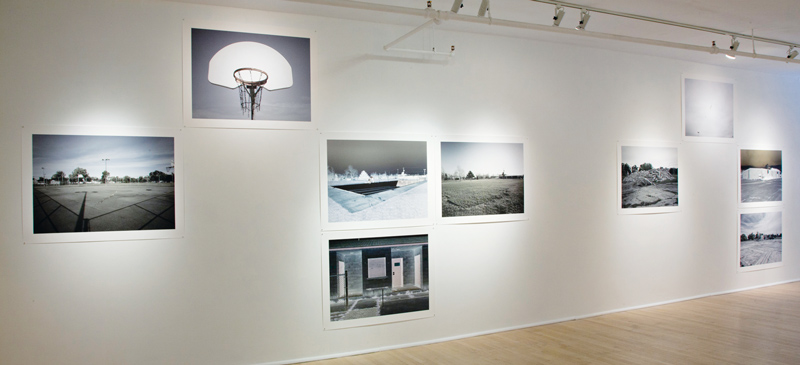À contretemps II : site spécifique
Galerie Laroche Joncas
August 23–September 23, 2017
By James D. Campbell
In this photographic essay, Sylvie Readman brilliantly addresses the strange topography of the abandoned military base at Saint-Hubert, Quebec, in terms of non-place and liminal space. Her fortuitous discovery of this site has resulted in some of her most memorable images to date.
The Saint-Hubert base was a locus of some notable historical events – to cite but a salient few, the arrival in 1930 of the British-made R-100 airship; its importance during the Second World War and subsequent expansion during the course of the Cold War; and the fact that, during the FLQ “October Crisis,” the body of Pierre Laporte was discovered nearby on October 17, 1970, and identified by a military doctor. In 1995, it was decided that the base would be dismantled. Its eloquent remnants are the focus of Readman’s project.
As we survey the images in this exhibition, we find a convincing embodiment of French anthropologist Marc Augé’s concept of the “non-place”:1 a space of transience in which the human subject is anonymous – and, in Readman’s work, only an interwoven web of traces. Like the highways and airports cited by Augé, the architectural structures of the abandoned military base and its eerie segregated and overlapping domains empty of human subjects are integers of nonplaces that resonate with melancholy, entropy, and the disintegration of all things.
In Sans titre (polyptyque, piscine-terrain de basket, 2017), the playground is deserted; the swimming pool is also deserted in Sans titre (polyptyque, piscine des officiers, 2017). There is a post-apocalyptic resonance in Sans titre (polyptyque, logement militaire, 2017). All these images remind us of the entropic settings so eloquently invoked by British speculative novelist J. G. Ballard in his dystopian short story “The Voices of Time.”[2]
Augé conceives a world overtaken by “supermodernity” – fraught with an “abundance of events.” He argues, “This need to give a meaning to the present, if not the past, is the price we pay for the overabundance of events corresponding to a situation we could call ‘supermodern’ to express its essential quality: excess.”[3] “Non-places” are legion in the supermodern environing world. These are the institutional spaces “formed in relation to certain ends (transport, transit, commerce, leisure).”[4] Supermodernity is understood as being a global incubator of non-place.
Consider the pathway to nowhere in Sans titre (polyptyque, logements militaires – chemin, 2017) and the abandoned, boarded-up military housing in Sans titre (polyptyque, logements militaires – conversion, 2017). Here are splendid exemplars of Augé’s “non-place” – a place diametrically opposed to the sociological idea of “place.” Like the empty airfield at the military base that Readman surveys, the sundry edifices required for the accelerated circulation of passengers and goods are the sine qua non of non-place.
For three years, Readman documented the base devotedly from stem to stern, summoning up a past that powerfully impinges on the present and future tenses. The phenomenon of excess is indissolubly wed here to the space of recess. Readman powerfully exposes the phenomenal interconnectedness between her images and the subjects that they depict, and she brings the temporal into play with seeming effortlessness. Her interstitial map of non-places is marked by a numinous, spectral dimension invoked not only through the markers of abandonment but through an overcast palette and frequent X-ray-like treatment of the image. This zone of entropic decay is one that the viewer projects into with alacrity, and one is transformed as a result.
Airports are non-places because one’s identity virtually disappears as one enters the airport. The abandoned military base is a hypertrophied specimen of this space that exists somewhere “between here and there,” in what sociologist Bruno Latour has termed a liminal space.[5] The solitude and similitude that mark the non-place are inscribed in Readman’s images with deft auratic finesse. The images of the abandoned military base speak to the past, a supermodern present tense, and a future that is paradoxically always already nipping at our heels.
2 J. G. Ballard, “The Voices of Time,” New Worlds 99, no. 33 (1960): 91–123; later published in The Voices of Time and Other Stories (New York: Berkeley, 1962).
3 Augé, Non-Places, 29.
4 Ibid., 94.
5 See Bruno Latour, Reassembling the Social: An Introduction to Actor-Network Theory (Oxford: Oxford University Press, 2005).
James D. Campbell is a writer and curator who writes frequently on photography and painting from his base in Montreal.
[Complete issue available here: Ciel variable 108 – GOING PUBLIC ]


